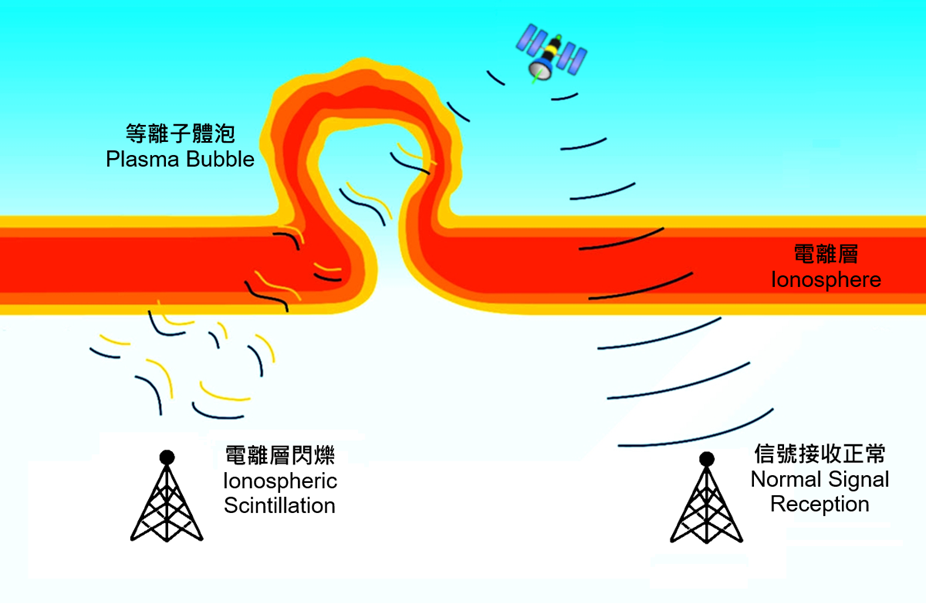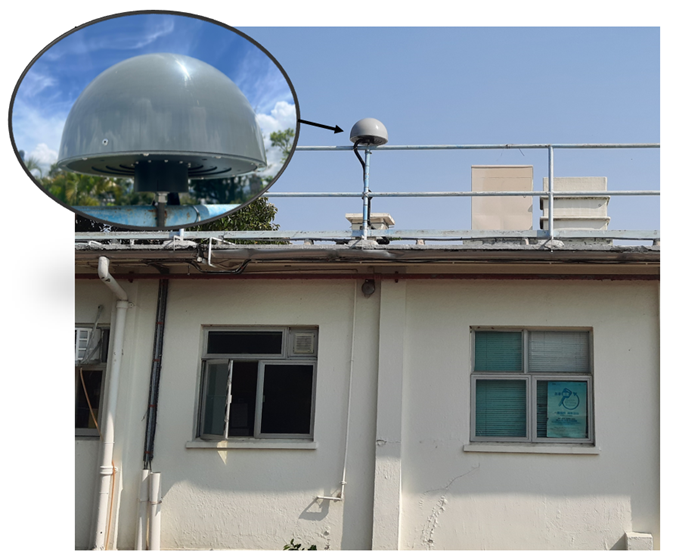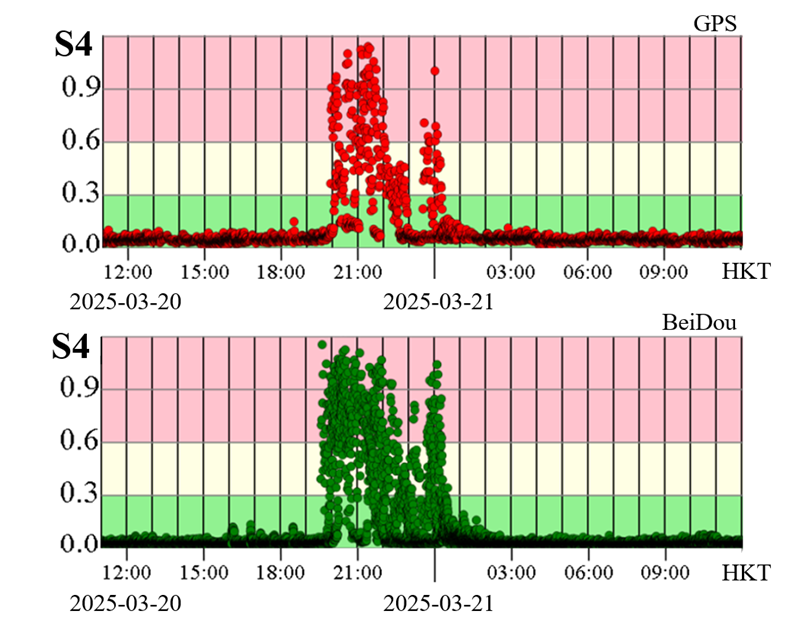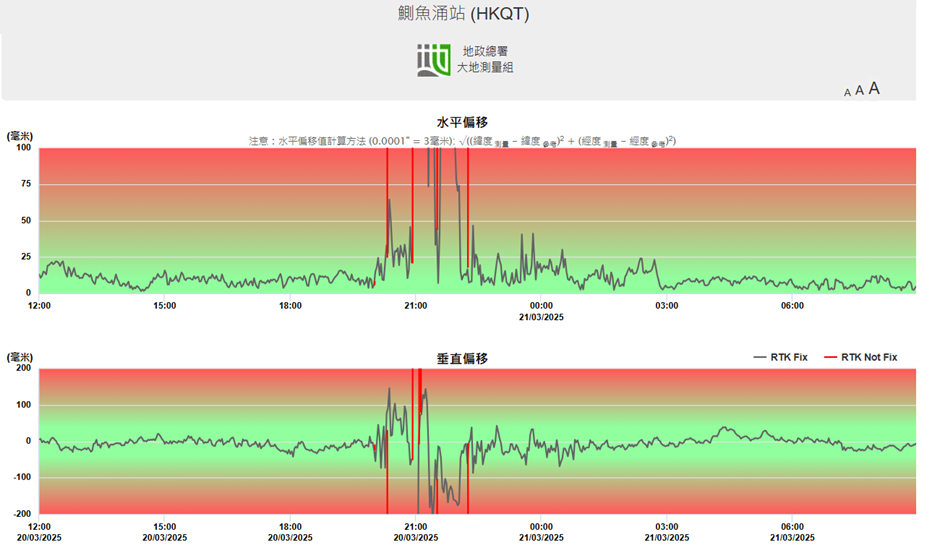Ionospheric Scintillation Monitoring
12 June 2025
LAM Ming-chun, LEUNG Wai-hung
What is Ionospheric Scintillation?
The ionosphere is part of the Earth’s upper atmosphere, located approximately 80 to 600 kilometres above sea level, where Extreme Ultraviolet and X-ray solar radiations ionize atoms and molecules, thus creating a layer of electrons.
When irregularities in electron density occur within the ionosphere, regions with lower electron density called plasma bubbles can develop. When radio waves pass through these areas, they experience refraction or scattering, causing rapid fluctuations in signal intensity and phase. This phenomenon of unstable signals received on the ground caused by ionospheric disturbances is known as ionospheric scintillation [1] (Figure 1).

In regions affected by ionospheric scintillation, mild conditions can reduce the accuracy and reliability of positioning systems, while severe conditions can prevent satellite receivers from locking onto signals and make position calculation impossible.
Timing and Locations of Ionospheric Scintillation
Ionospheric scintillation is influenced not only by solar activity but also by geographic location, seasonal changes and diurnal variations.
In low-latitude regions, scintillation is generally most prominent between sunset and midnight. After sunset, the sharp decline in solar radiation weakens the ionization effect, causing uneven electron density distributions and significant density gradients. The combined effect of the electric field associated with this gradient and the geomagnetic field unique to low-latitude regions triggers instability in the ionosphere and development of plasma bubbles, consequently leading to ionospheric scintillation. Mid-latitude regions experience fewer scintillation events due to less favourable conditions, though scintillation can still occur during strong geomagnetic storms [2].
Scintillation activity is more frequent during the spring and autumn equinoxes, which is attributed to the angle of direct sunlight and favourable geomagnetic conditions [3].
In addition, the solar activity cycle has a period of about 11 years. The peak of the last solar cycle occurred in 2014 and the peak of the current cycle is in 2025 [4]. During the peak of the solar cycle, solar activity and geomagnetic disturbances increase, and ionospheric scintillation can occur more frequently.
Ionospheric Scintillation Monitoring
In March 2025, the Hong Kong Observatory installed a Global Navigation Satellite System (GNSS) receiver at the King's Park Meteorological Station (Figure 2) to monitor scintillation in real-time. Operating at a high sampling rate of 50 Hz (i.e. 50 times per second), the receiver collects data from the Global Positioning System (GPS), BeiDou Navigation Satellite System, and other satellite navigation systems. Since ionospheric scintillation causes intensity fluctuations and phase changes during GNSS signal propagation, ionospheric scintillation activity can be monitored by analysing the changes in the received signals.

Currently, the S4 index is generally used internationally to quantify the intensity of ionospheric scintillation. Calculated as the ratio of signal intensity standard deviation to its mean over a certain period, it categorizes scintillation events into three levels:
| Minor scintillation: | S4 < 0.3 |
| Moderate scintillation: | 0.3 ≤ S4 < 0.6 |
| Strong scintillation: | S4 ≥ 0.6 |
When the scintillation event reaches the strong category, it can cause significant positioning errors or complete signal loss in the satellite positioning system.
Within just a few months after installation of the GNSS receiver, the Observatory has successfully detected a number of ionospheric scintillation events. On the night of the spring equinox on 20 March this year, a relatively strong scintillation event was recorded in Hong Kong. Figure 3 shows that the S4 indices from many GPS and BeiDou satellites reached the strong scintillation category.

On the other hand, the Lands Department has set up monitoring stations over the territory to receive GNSS satellite data for positioning purpose. The coordinates measured by satellites are compared with the known coordinates and the deviations are available online in real-time [5]. On 20 March, the webpage of the Lands Department's Quarry Bay monitoring station showed that for a period of time after about 8 o'clock, there were large horizontal and vertical deviations between the coordinates measured by satellites and the known coordinates, indicating that the accuracy of the satellite positioning system was significantly affected (Figure 4).

The Observatory will continue to optimize the ionospheric scintillation monitoring system and use real-time monitoring data to enhance space weather related services, including support for drone-based low-altitude economy activities in Hong Kong.
References:[1] 香港天文台:太空天氣會影響日常生活嗎 ? (in Chinese only)
[2] Li, G., Ning, B., Otsuka, Y. et al. (2021). Challenges to Equatorial Plasma Bubble and Ionospheric Scintillation Short-Term Forecasting and Future Aspects in East and Southeast Asia. Surv Geophys 42, 201–238.
[3] Cheng, J., Xu, J., & Cai, L. (2018). A comparison of statistical features of ionospheric scintillations and cycle slips in the mid-south region of China. Chinese Journal of Geophysics, 61(1), 18-29.
[4] U.S. National Weather Service, National Oceanic and Atmospheric Administration: Hello Solar Cycle 25
[5] Lands Department: SatRef Network RTK Integrity Monitoring webpage